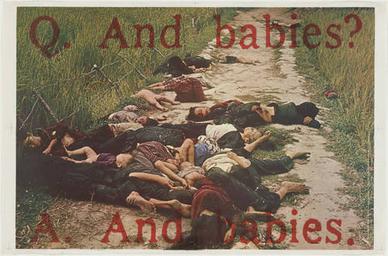
And babies (December 26, 1969[2]) is an iconic anti-Vietnam War poster.[1] It is a famous example of "propaganda art" from the Vietnam War,[3] that uses a color photograph of the My Lai Massacre taken by U.S. combat photographer Ronald L. Haeberle on March 16, 1968. It shows about a dozen dead and partly naked South Vietnamese women and babies in contorted positions stacked together on a dirt road, killed by U.S. forces. The picture is overlaid in semi-transparent blood-red lettering that asks along the top "Q. And babies?", and at the bottom answers "A. And babies." The quote is from a Mike Wallace CBS News television interview with U.S. soldier Paul Meadlo, who participated in the massacre. The lettering was sourced from The New York Times,[4] which printed a transcript of the Meadlo interview the day after.[5]
According to cultural historian M. Paul Holsinger, And babies was "easily the most successful poster to vent the outrage that so many felt about the conflict in Southeast Asia."[1]
- ^ a b c Holsinger, M. Paul (1999). "And Babies". War and American Popular Culture. Greenwood Press. p. 363. ISBN 9780313299087.
- ^ Cite error: The named reference
Frascinawas invoked but never defined (see the help page). - ^ Cooper, Daniel (2003). "Art". In Nicholas John Cull (ed.). Propaganda and Mass Persuasion: A Historical Encyclopedia, 1500 to the Present. ABC-CLIO. p. 23. ISBN 9781576078204.
Propaganda art found more fertile ground in criticizing the U.S. government during the Vietnam conflict through works such as the famous Art Workers Coalition piece Q. And Babies? A. And Babies (1970) which commented on the horrors of the My Lai incident.
The poster is also discussed in Moore, Colin (2010). Propaganda Prints: A History of Art in the Service of Social and Political Change. A&C Black. p. 181. and in Brewer, Susan. Why America Fights: Patriotism and War Propaganda from the Philippines to Iraq. Oxford University Press. p. 221. - ^ Cite error: The named reference
Israelwas invoked but never defined (see the help page). - ^ Cite error: The named reference
NYT Interviewwas invoked but never defined (see the help page).
© MMXXIII Rich X Search. We shall prevail. All rights reserved. Rich X Search
